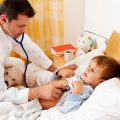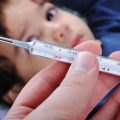Sepsis is a severe infectious disease, that develops, when the infectious process progresses and spreads throughout the body via the blood. In people, the disease is referred to as blood poisoning. Hippocrates noticed, that sepsis is associated with the decay and decay tissue, If this process is not stopped in time, it inevitably leads to the death of a man.
The etiology of sepsis is, that it can be caused by many micro-organisms: staphylococci, meningococcus, E. coli, stryeptokokkami, pneumococci or fungi. Basically, this pathological process develops due to an unfavorable course of purulent inflammation of soft tissues, eg, in abscess or peritonitis, the general weakening of immunity. The disease is characterized by progressive course with no tendency to a rapid and spontaneous recovery. Despite, It is now considerably increased the possibility of antibacterial and antifungal treatment, mortality during sepsis infection remains high.
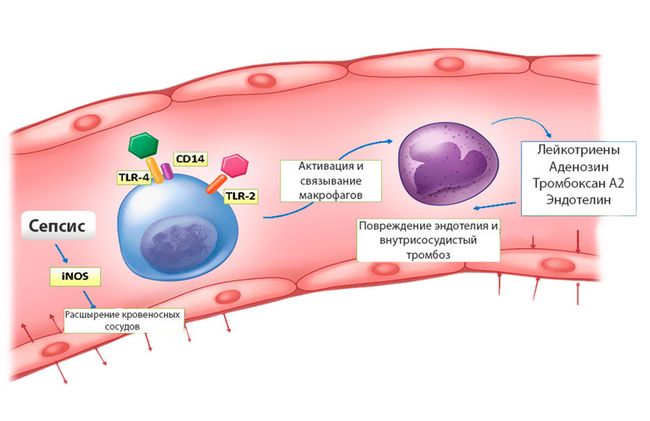
Causes sepsis
Among the possible causes of sepsis release:
- congenital and acquired disorders of the immune system, immunodeficiency in AIDS step;
- the presence of infective endocarditis;
- festering wounds in appearance;
- injecting drug (angiogenic sepsis);
- the presence of chronic purulent pathology (trophic ulcers);
- the occurrence of infected venous catheters;
- Local complication of purulent processes (cellulitis, abscess, lactation mastitis) and peritonitis;
- injury infectious nature;
- burns severe;
- extensive wound surface, open fractures, especially in weak patients with major blood loss;
- the development purulent infections in the mouth;
- pathological increase of resistance of microorganisms to antibiotics;
- Infectious complications of labor or abortion;
- the occurrence of septic complications after surgery;
- medical procedures - vascular catheterization, prosthetics and other.
- damage to the organs of the urogenital system;
- non-compliance with the rules of aseptic and antiseptic in the treatment of purulent wounds and operations;
- incorrect prescription medications and their dosages doctor;
- as a result of complications of severe angina, pneumonia, purulent processes in the lungs, Rahit, diabetes, cirrhosis of the liver, osteomielita, running ear;
- cancer in the later stages, leukemia;
- long receiving immunosuppressive.
This is not an exhaustive list of possible causes, cause the development of sepsis. Diseases can complicate almost any pathology of infectious and inflammatory nature. Its development may contribute to chronic diseases, injury, bleeding, taking over most of the protective properties of the organism. The immune system is constantly struggling with foci of chronic inflammation (bronchitis, caries, colitis, etc.), therefore protective properties are insufficient, to cope with the new disease. Also frequent sepsis in children and old people, because their immune system is not working at full strength. At the same time, not every infection, even highly aggressive, can go into sepsis. If a person initially healthy, it is most likely with the help of medication to cope with the disease, without getting further spread.
Person, boleyuschyy sepsis, It is not contagious and dangerous to others, which is not the septic forms, which can flow and certain communicable diseases - scarlet fever, meningitis, salmonelleze. In these cases, the person is infectious, and the doctor does not put his diagnosis "sepsis", Although symptoms will be similar.

Pathogenesis
Pathogenesis of sepsis occurs in several stages:
- The penetration of agent into the body and the formation of the primary center - may occur in different ways: droplets, alimentary, through the skin and the entrance gate. The most common are umbilical infection and sepsis due to unsterile paced held vascular catheterization, in third place is the infection sepsis, in which the gateway becomes easy, as a result of primary pneumonia or nosocomial infection, which occurs during intubation or nonsterile held suction mucus.
- Bacteremia - the introduction of microorganisms in the blood.
- Toksinemiya - occurs when the active allocation bacteria toxic substances.
- The spread of pathogens to internal organs with the occurrence of secondary foci.
- Activation of immunity - as a result of anti-inflammatory mediators are released, but the process can not be completed in full, which leads to the accumulation of cytokines.
- Destruction of tissue cells with impaired perfusion, causing shock.
- Septic shock - severe sepsis, causing hemodynamic instability and the occurrence of multiple organ dysfunction syndrome.
Classification
According to the occurrence of hearth:
- Primary or cryptogenic - appears without a pronounced purulent center.
- Secondary - occurs against a background of already existing or purulent inflammation.
Depending on the duration of flow:
- Fulminant (sharpest) - sepsis symptoms appear and grow at a rapid rate, severely disrupted the functioning of the internal organs and the condition of the person is deteriorating rapidly. Often develops in abrasions and carbunculosis person. after 1-2 day of death can occur.
- severe sepsis - symptoms increase more slowly, duration of the disease comes up to six weeks. It meets all the most. The mortality rate is less, but also it remains high.
- Podostrый - lasts from six weeks to four months. Usually ends in recovery or becomes chronic.
- palindromic - it takes up to six months or longer. Improvements replaced exacerbations, that is, the disease runs in waves.
- Hroniosepsis (chronic) - lasts for several years, eventually causing the degeneration of internal organs.
There are different types of sepsis, which differ in the mechanism of development and types of pathogens:
- The most common is a surgical sepsis. Its complications cause various suppurative disease or damage (wounds, fractures, burns).
- Obstetric, neonatal (neonatal sepsis) - is prenatal and postnatal, occurs when septic pathologies health workers or mothers. This infection is very dangerous, transmitted through a variety of subjects, and it penetrates through the wound, skin, infant formula, respiratory system. Suppuration is in the field of infection.
- Otogenny Sepsis is very dangerous, it is a consequence of suppurative otitis media, and often leads to infection penetration into the lining of the brain, that provokes meningitis.
- Rhinogenous septicemia - most often caused by a complication of purulent nasal and paranasal sinuses pathologies.
- Urosepsis - develops when inflammation of the urogenital system (urethritis, cystitis, pyelitis, jade, bartolinita, prostatitis).
Depending on the process, that occur in the body:
- septicemia - there is the occurrence of systemic inflammation, but no pus pockets. It flows more often in acute form or lightning.
- pyosepticemia - a form of sepsis, in which the various bodies appear purulent education.
- Septicheskiy sepsis - a type of septicemia, whereby inflammation focus is located on the surface of the heart valves.
Development time:
- Early - there is up to 14 days from the time of formation of a purulent focus. It appears on the type of strong allergic reactions in sensitized body.
- Late - comes through 14 or more days after the primary focal suppurative. Its cause is the development of sensitization on prolonged purulent process.
The phases of development:
- voltage phase - causes a sharp attraction of protective functions of the body by stimulating the pituitary-adrenal system.
- Katabolicheskaя stage - there is protein catabolism, fats and carbohydrates, violation of water-salt and acid-base balance.
- anabolic - there is a transition on the anabolic metabolism pathway, first there is the process of restoring the structural proteins.
- rehabilitation - it appears full recovery of all metabolic processes, occurring in the human body.
symptoms
sepsis Clinic depends on the focus and type of pathogens, but there are some typical symptoms. Signs of sepsis:
- the occurrence of severe chills;
- Body temperature rise;
- very abundant perspiration.
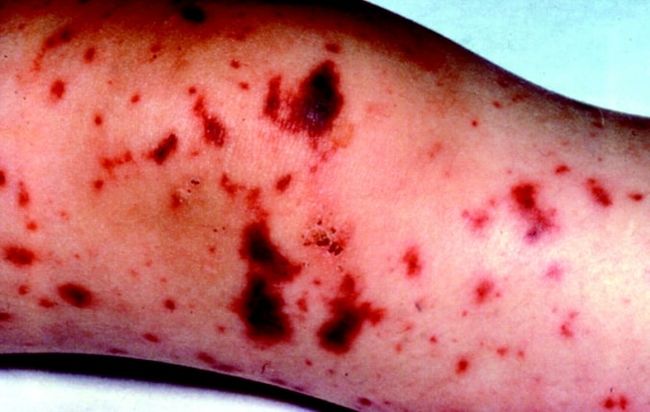
These are the three main symptoms, which are permanent clinical manifestations of all kinds of sepsis. In addition to them, you can designate:
- occurrence of bleeding of mucous;
- the occurrence of cold sores on the lips;
- disruption of the respiratory system, the appearance of shortness of breath;
- nausea, vomiting, diarrhea, severe abdominal pain;
- lowering blood pressure;
- formation of ulcers on the skin and seal surface;
- decrease in urine;
- sallow skin tone;
- fatigue and apathy of the patient, changes in the mind of the excitation state to the full apathy and stupor, complete rejection of food, disorientation, drowsiness, confusion, coma;
- sunken cheeks with a bright unhealthy flush against the overall paleness;
- bruising on the skin in the form of spots and streaks, to a greater extent on the extremities.
Important! In the event of suspicion of sepsis, should immediately call the medical, to begin therapy should be promptly, because this infection can cause death very quickly.
Sepsis in neonates
Sepsis in early infancy are most susceptible to premature and weak children. Depending on the appearance, distinguish between early and late onset neonatal sepsis. Early neonatal sepsis is characterized by the occurrence of disease in the child during the first three days of life. This type occurs when prenatal or early postnatal infection infection. Often, the primary site of infection is the intrauterine pneumonia. The source of infection in this case are the pathogens from maternal genital tract, but there is no path and transplacental infection. Late neonatal sepsis is diagnosed when a disease in infants older than three days of life, while infection occurs after birth.
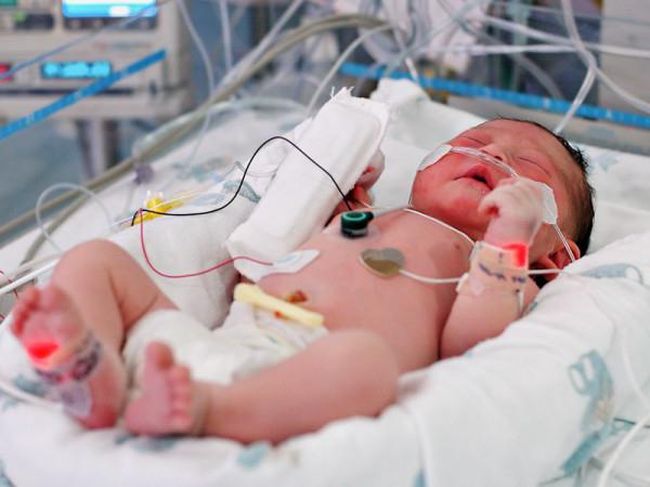
Sepsis in infants manifested by the following symptoms:
- the appearance of vomiting and diarrhea;
- refusal to supply;
- rapid weight loss;
- dehydration, as a result of which the skin becomes dry, Stiff with an earthy shade;
- are often festering in the area of the umbilical wound, deep cellulitis and abscesses in various locations.
In sepsis consequences of not encouraging the newborn baby. There is a large percentage of deaths, and surviving babies also have a tough time, lifetime they will be accompanied by the consequences in the form of:
- pulmonary pathologies;
- frequent acute respiratory viral infections and acute respiratory disease with complications;
- cardiac pathologies;
- anemia;
- delays in physical development;
- CNS.
diagnosis of sepsis
Methods of examination in this disease are assigned depending on the shape and localization hearth. For diagnosis can be assigned:
- laboratory tests of blood and urine;
- ultrasound;
- X-ray studies;
- CT scan;
- ECG;
- MRT;
- microscopic examination.
Diagnose blood poisoning is difficult, is often, that the primary focus is not defined, and the disease has a smeared picture.
therapies
In case of sepsis therapy should be integrated and extends in a hospital. Physicians should keep in mind the high probability of complications and risk of death.
Scheme activities for the treatment of sepsis includes:
- antibiotekoterapiyu - use of antibiotics in sepsis, destroying pathogenic microorganisms, causing infectious process;
- immunotherapy - purpose funds, which increase the protective functions;
- detoxification - is carried out upon detection of severe intoxication in the body;
- anti-inflammatory therapy - performed with the use of corticosteroids and non-steroidal anti-inflammatory drugs;
- elimination of symptoms of sepsis and disorders in the body, recovery operation of the internal organs using drugs;
- surgery to remove purulent foci;
- antishock therapy - is carried out in the case of infectious-toxic shock.
In the treatment of sepsis patient should easily digestible and balanced food. In everyday diet should be fresh fruits and vegetables, lean meat, a fish, dairy products. The patient must abundant as purified drinking of carbonated water, fresh juices and green tea.
Forecast
Prognosis in adults with any form of sepsis always serious. The faster diagnosis and treatment is started, the greater the chance of recovery. Unfortunately, it is not always possible, since there are many diseases erased forms, in which the clinical picture is not expressed.
Positive outlook for various septic conditions depends on:
- virulence and specific characteristics of the microflora, which caused the pathology;
- the general health of the patient, the immune system, concomitant diseases;
- timely and competent treatment.
note! It is important to note, that in each case it has a complex for sepsis. The mortality rate reaches 50%, and in septic shock percentage is even higher. All people suffer a serious illness in elderly and pediatric.
preventive measures
Prevention of sepsis includes:
- timely elimination of purulent infections;
- effective treatment of local processes of infectious and inflammatory;
- aseptic and antiseptic rules for therapeutic and diagnostic measures and operative interventions;
- Prevention of nosocomial infections;
- adequate therapy of infectious processes of any localization;
- vaccination against pathogens, vzыvayuschyh sepsis.







